Advanced Leadership Guide
Inbound LeadershipInbound leadership is a philosophy wherein leaders operate from a “How can I help?” perspective, and are obsessed with the success of their people and teams. This approach leads to a positive and lasting impact on the organization.
As an inbound leader, you enable your people to be engaged, to choose to own their future within your team or organization.
They aren’t simply completing tasks because you asked them to; instead, they are completing tasks because they understand how their contributions fit into the bigger picture and your mission.
If you are a leader who seeks to be a catalyst for positive change, empowers their people to be successful, and helps others “catch the vision” of what you’re trying to build, this guide is my personal invitation to you to walk the path of an inbound leader.
Because inbound isn’t just for marketers anymore.
Are you ready?
Chris brings over a decade of multifaceted leadership experience from both the military and business world. Driven by a desire to inspire and develop others, he is known as a high-energy leader always working to better his team and their clients. He has a BA in liberal studies from Thomas Edison State College and an MS in organizational leadership from Quinnipiac University. When not working to inspire and develop his team, Chris can usually be found on a golf course, or with his wife and two kids.
Fill out the form for a downloadable PDF version of the guide you can reference later.
Chapter 1
Based on years of observation, application, experimentation, and intense study of leadership principles, inbound leadership is the marriage of several leadership philosophies and ideologies -- none more influential, however, than IMPACT’s Inbound Manifesto.
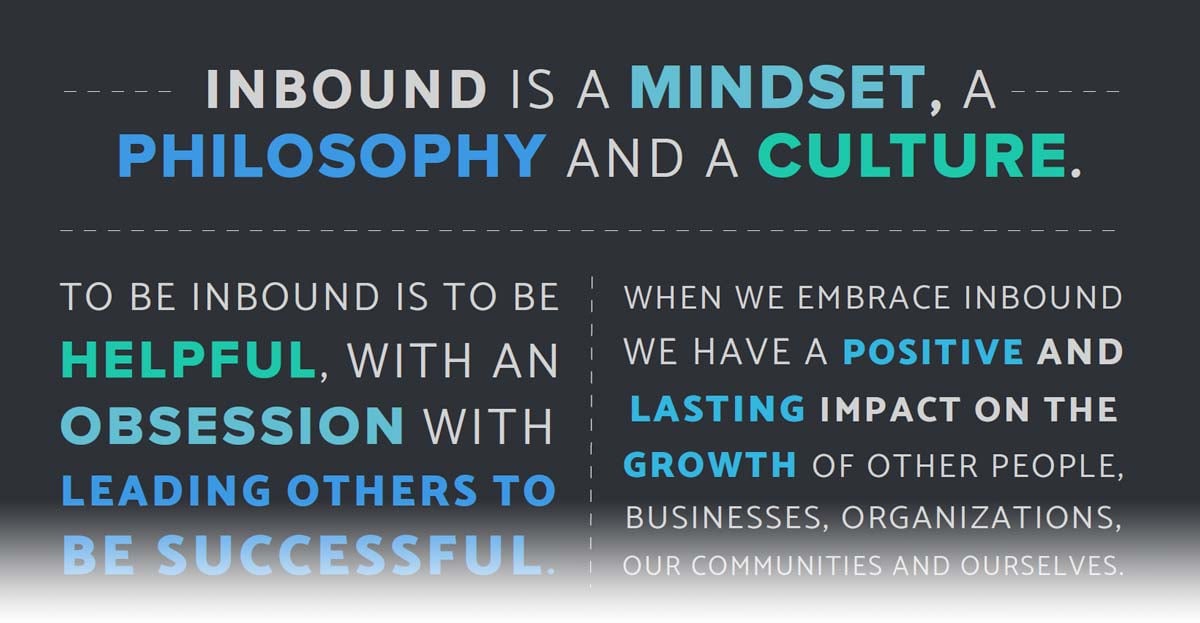
View IMPACT's Inbound Manifesto.
In our Inbound Manifesto, we redefine inbound as a mindset, a philosophy, and a culture that is driven by an altruistic obsession with helping others be successful, rather than a one-dimensional collection of marketing and sales tactics.
There are also two other well-known approaches to leadership that feed into the concept of being an inbound leader that I have found invaluable in both the military and in business:
“The servant-leader is a servant first… It begins with the natural feeling that one wants to serve, to serve first. Then conscious choice brings one to aspire to lead.” (Robert K. Greenleaf)
“[A] style of leadership in which the leader identifies the needed change, creates a vision to guide the change through inspiration, and executes the change with the commitment of the members of the group.” (Business Dictionary)
(We'll talk more about these styles later on in this chapter.)
Fundamentally, as an inbound leader, you are committed to being “others-focused” rather than self-focused. You are obsessed with helping your people succeed. It is a distinct shift away from what is the norm for many who sit at or near the top of an org chart, where the leader takes credit for their people’s work.
Through my years as a commissioned officer in the United States Army, I saw many different types of leaders.

That's me on the right.
There were inspirational leaders who I now realize were inbound leaders themselves and never even knew it. Then, of course, there were those leaders who acted like Henry VIII -- simply barking orders and expecting things to get done, “or else.”
And then there were a few who lived somewhere in between those two extremes.
Personally, I have been on both sides of the spectrum as a leader. In my early years, I clung to power and praise. Now, I find myself overwhelmed (positively) when people on our team succeed.
I tell you all of this so you know it’s a journey to walk the path of an inbound leader. Some days you will be the best leader in the world. Other days? Not so much. (We’re only human.)
If you choose to continue on this journey of self-discovery as an inbound leader we are embarking on, here is what you are going find:
Now, let's get after it...
Much of the pain and frustration we experience as leaders -- unmet expectations, unengaged teams, turnover, etc. -- are often self-inflicted wounds, rooted in the way most of us think about leadership, the way leadership is taught to us, and, ultimately, how we act as leaders.
Common flawed leadership behaviors include:
Using fear to lead your team or organization.
Viewing your people as nothing more than a resource.
Focusing only (or primarily) on short-term results.
Not underwriting the actions of your people.
Not trusting anyone.
Thinking to be a leader is to be better than others.
Through these behaviors -- often reinforced and validated as effective in some academic leadership teachings and in pop culture -- we have created a rift between ourselves, as leaders, and our people.
Often, many who fall into these habits do so because the behavior was modeled as appropriate by leaders in the past, creating a vicious cycle.
But now is the time for us to recognize and label these leadership practices as harmful to organizations.
Yes, that’s a bold statement to make, but the data only further underscores how the modern American workforce now rejects “old school” leadership practices.
According to Gallup’s State of the American Workforce Report (2017 to 2018), only 33% of American workers are engaged at work. In this context, to be engaged is defined as employees that are involved in, enthusiastic about, and committed to their work and workplace.
On top of that, 16% are actively disengaged, which costs American businesses between $483 billion to $605 billion a year in lost productivity.
Here’s another scary statistic that is sure to surprise a few of you -- 65% of American workers would rather see their boss get fired than receive a raise.
Then, there's the job market landscape.
The U.S. job market has stabilized in recent years, now favoring job seekers, rather than employers. So, it's becoming increasingly difficult to attract and retain the top talent you need to make your organization run.
From that same Gallup report:
51% of U.S. employees say they are actively looking for a new job or watching for openings.
Currently, 63% believes it is “very likely” or “somewhat likely” that they would find a job as good as the one they have, up from 42% who said the same in 2010.
Employees also have a more “grass is greener” mentality than in previous years. In fact, an overwhelming majority of employees (91%) say the last time they switched jobs, they left their employer to do so.
So, we have to ask ourselves, “Why are employees leaving?”
What we find when we dig deeper is that employees are leaving for career growth opportunities, increases in pay and benefits. They are leaving to find a better job fit or companies with a better culture.
But many of them are leaving because of their manager or company leadership.
So, ask yourself this:
Bottom line, what will it cost our business if our leaders continue leading in a way that drives these types of numbers and behaviors?
And how much value can be added by having leaders who truly lead?
There is a leadership problem in the workforce that must be addressed if we want our businesses to survive.
Inbound leadership addresses these challenges head-on, because it is a human-to-human approach.
Inbound leadership addresses many of the root problems we see in other approaches to leadership that have gotten us to this point. Rather than solely focusing on short-term results, inbound leaders focus on their people and the long-term growth of their organization.
Inbound leaders build trust, earn respect, and ensure their people are treated as people.
The time to discuss a new approach to leading is now. If we do not work on this issue, we will have generations of workers who will never know what it feels like to be fulfilled by the work they do. They will always look at management and leadership with disdain.
If we choose now -- today -- as our time to teach leaders that there is another way -- a way that includes their people, on a human level, a way that focuses on their team’s successes -- we may be able to turn the tides and re-engage the workforce.
HubSpot’s CTO and cofounder, Dharmesh Shah, recently said:
“Success is making those who believe in you look brilliant.”
That is how inbound leaders talk.
That is how we make this shift from a “Do this, because I’m the boss!” mentality to a “How can I help?” mentality.
As I said at the start of this, making this shift in your thinking isn’t easy. It will take time and training, but if you take the ideas laid out here and bring them back to your organization or team, you will set yourself, your people, and your organization up for real success.
How did we get to a place where only a third of the workforce is engaged at work? Where only 15% of employees strongly agree that the leadership of their organization makes them enthusiastic about the future?
Let’s take a trip in our time machine to August 5, 1981.
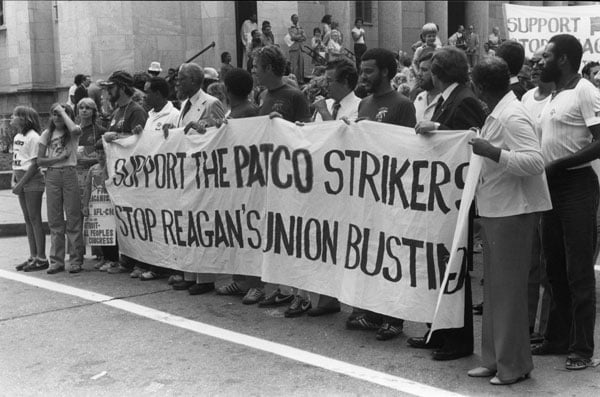
Photo Credit: George State University
On this day in history, leaders realized they could fix their bottom line by conducting layoffs when then-President Ronald Reagan fired 11,000 air traffic controllers who were involved in a labor dispute. It was a headline that created a cultural moment, where employees stopped feeling safe and part of the team.
Instead, the message was, “Members of the American workforce are expendable resources whose only purpose is to create value for stockholders.”
This isn’t to say that employees were ever truly the prime stakeholder to an organization, but this was the first time that layoffs were used as a financial tool so publicly and at such a large scale.
That said, there has always been a rift of some sort between management and labor, with management doing whatever it needed to increase profits, and labor working to increase workplace safety, fair wages, and benefits.
So, when layoffs became a norm, the divide between the two groups only deepened.
Just think about your parents or grandparents.
How many of them worked for one maybe two companies their entire life and at age 55 or 65, they retired, got their gold watch, and collected their pension? That was very common for previous generations.
Now, how likely are employees today to have that happen? (There’s a good chance you’ve already worked at more than two companies, yourself.) Also, how likely are employees to want to have that happen today?

During this time period is when one of America's most well-known CEOs took the reins at General Electric, Jack Welch. To this day, many speak of Welch as an iconic leader who elevated GE to new heights and levels of success with his management system.
Under Welch, GE would rank all of the people and let the bottom 10% go as a practice in continuous improvement.
In essence, your underperformers would leave and the remaining 90% of your team would work as hard as they could to ensure they didn’t end up in the bottom 10%. This is a very simplified view of this.
Many companies embraced this practice, and Welch was heralded as a performance management genius -- under his system, a company would keep only people who were performing, which would mean a higher return shareholders.
Today there are still organizations that follow this performance management philosophy. They see it as a way to motivate their teams to always be improving.
While this system may drive some positive performance outcomes, the second and third order effects can adversely affect a business.
While competition is a good thing, when individual performance is life or death, people naturally take care of themselves. They become less helpful. They focus only on the immediate tasks in front of them and stop looking at the bigger picture.
And when management and leadership begin to act this way, they stop caring about their people and start thinking of their staff as an expendable, faceless resource to help them hit their revenue goals to ensure they are in the top X%.
This is when your people will disengage -- when they are no longer valued.
This top-down, authoritative leadership approach may yield short-term gains, but what are the long-term implications?
 At the same time Jack Welch leading by fear of the ax at GE, Jim Sinegal was at the helm of Costco. Unlike GE during the time of Welch, Sinegal focused on people, rather than shareholder value.
At the same time Jack Welch leading by fear of the ax at GE, Jim Sinegal was at the helm of Costco. Unlike GE during the time of Welch, Sinegal focused on people, rather than shareholder value.
Sinegal ran the organization according to four core values, which they codified into the Code of Ethics:
Obey the law.
Take care of our members.
Take care of our employees.
Respect our vendors.
"If we do these four things throughout our organization, then we will achieve our ultimate goal, which is to reward our shareholders."
Costco’s messaging here is clear -- if you take care of the people who make it possible to do business (employees and suppliers) and the folks who buy from you (customers) in accordance with the law, you will deliver for your shareholders.
Under Sinegal, Costco paid their people a fair wage, offered benefits for hourly workers, and built a culture where people wanted to work.
They took pride in being a Costco employee. The organization placed a higher value on their employees as a way to drive greater value for their shareholders. The employees and suppliers were the focus, not just the dollars.
This approach stands in stark contrast to the GE model, which eliminated employees under the banner of “continuous improvement,” in order to maximize shareholder value.
The results speak for themselves.
If you had invested $1,000 in both GE and COSTCO in January of 1986 and kept it in the market until October of 2013, you would have made $600,000 in GE and $1,200,000 in Costco. Throughout this period of time, GE’s stock was more volatile, while Costco was on a steady up and to the right path.
If we can agree that sustained, long-term success is what we are looking for in our businesses and organizations, then we need to begin leading those businesses and organizations using a long-term leadership approach.
Ranking and cutting people, and creating a culture of competition doesn’t create long-term success, but rather short-term spikes that are not sustainable. When we force our people to compete with each other, they don’t help each other, which means that people are moving in different directions and aren’t aligned.
They are focused on doing what is best for them in the short-term, unconcerned with what the organization is trying to achieve.
When we, as leaders, create environments where we are focused on long-term success, we focus our time, resources, and energy into developing our people. We create cultures of compassion, where a common question is, “How can I help?”
Under inbound leadership, team members and leaders are focused on everyone succeeding, rather than simply making their team or department look good. They are focused on achieving the organization’s long-term goals; they are focused on the collective win, not just the individual win.
The key here is in how we set the tone for the organization.
The days of top-down, authoritative leadership are coming to an end.
To be effective today, you need to embrace this new way to lead. One that is inclusive, focused on long-term success, and centered around the people in your organization.
Once upon a time…
So, like all great superheroes, inbound leadership wasn’t simply formed -- there’s an origin story, where a confluence of events, learning, problems all came together to create what we call inbound leadership.
Even before I left the Army, it was clear to me that short-term focus didn’t drive overall success.
Like anyone who has served, I’ve had a ton of experience with great leaders -- but I also had about the same amount of experience with leaders who taught me really important lessons on how not to do things.
This isn’t to say they were bad people, they were simply short-term and self-focused. They were top-down command-and-control types, who had to have everything done their way.
There was little room for innovation and, frankly, little focus on development. Everything was focused on achieving the task at hand at any cost.
I struggled when working for these leaders. I didn’t feel valued, and I didn’t enjoy going to work. Every email, phone call, or meeting was an opportunity to be told how we weren’t meeting expectations, or how we had found a new and innovative way to screw something up.
In contrast, when I had leaders who were focused on developing their teams in order to achieve a goal, I thrived. These were the leaders who assigned books to read and then held conversations about what we read at lunch.

They are the leaders that challenged me to learn, to be better every day.
As I left the Army, I began reading a ton of business and leadership books and enrolled in Quinnipiac University’s master of science program in organizational leadership. I had to figure out how to not only lead outside the Army, but also how to be a business person who wore suits and ties.
While in my first job and attending graduate school, I began to see that there was no real difference in leading in the Army versus the civilian world.
In fact, I saw the same leadership issues from the Army at the company I was working for.
Refining My Leadership Ideal
Through my studies and experience I developed my ideal version of a leader:
Someone who inspires others, develops and articulates a vision, establishes and maintains a positive environment within a group or organization, inspires growth and development of their people, shows trust by delegating authority and underwriting decisions made, and someone who truly cares about the organization and the people within it.
There are many styles and approaches that have been defined over time with regards to leadership. When putting together my ideal version of a leader, I initially relied heavily on the concepts I mentioned before of transformational leadership and servant leadership.
To review...
Servant leadership is the idea that the leader is a servant first, serving those they are entrusted to lead.
Transformational leadership is the idea leaders need to manage change through vision and inspiration.
Looking at servant leadership and transformational leadership as models, I still felt dissatisfied. While there is a focus on the people being led in these two approaches, workers were not the hero; they were not the main character in this leadership story.
The other approach that came to mind -- as an example of what I felt was wrong with leadership -- was the transactional leadership model. (This is the more command-and-control, top-down style I mentioned earlier.)
While it’s important to hold people accountable and manage performance, I have found that when leaders solely use this style, they are usually more short-term focused and create environments that are more negative.
The idea here is that everything is simply a transaction. “If you do this, then you’ll get that.”
Instead of developing and building your team up, you resign your employees to being order takers and never grow into future leaders. This leads to people feeling disengaged and unfulfilled, breeding dissent and hurting your team or organization.
Still, this vision of leadership -- although closer to what I believed was needed -- was still a patchwork of disparate philosophies and experiences, instead of a cohesive, single source of truth on being an effective leader.
One day earlier this year, a group of senior leaders at IMPACT were talking about what the word “inbound” meant.
We asked ourselves, “Is inbound simply a marketing tactic we use, or a strategy -- or is it something more?”
The answer was yes, inbound is something more. I sat there as we discussed how the principles of inbound applied to how we marketed, sold, and engaged our audience.
Inbound is a philosophy, a mindset.
We believe inbound is rooted in this obsession to put others before yourself. To teach and guide people as much as you possibly can, so you can help them reach their goals on their terms. And, in turn, you will also be rewarded.
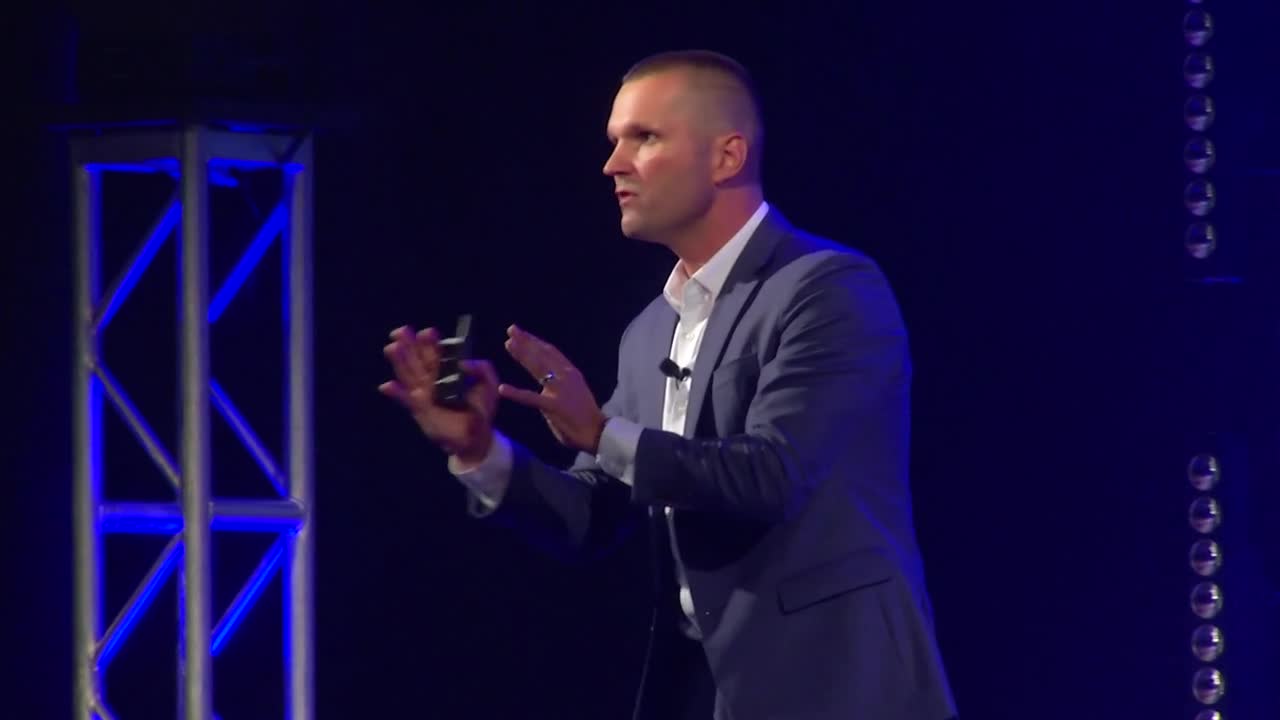
Watch Marcus Sheridan discuss our vision of inbound at IMPACT Live.
Then it all clicked.
This was it. This was the missing piece to how to define a way to lead today.
We could take the foundations of servant and transformational leadership, and layer in the principles of inbound to develop a leadership philosophy that would be long-term focused, adaptable to change, and, most importantly, address the world from a “How can I help?” posture.
We could teach leaders how to become obsessed with their people’s development and success, and how that could drive long-term results for our organization.
At that moment, inbound leadership was born. And I became obsessed with figuring out how to teach our leaders how to embody this new approach.
This idea, this new approach to leading, reflects what I believe is necessary today to re-engage our employees and teams.
By being obsessed with helping our people and enabling their success, we have the ability to solve our low employee engagement problem, create more opportunities for personal growth, and build organizations that people love.
But what does inbound leadership look like in practice? And how can you apply it to your team or organization?
That’s exactly what I will be teaching you in these remaining chapters, as our goal is to create more organizations that are focused on developing their people; that is where your success begins.
Chapter 2
Just like building a house, you must start your adventure of inbound leadership with the establishment of a strong foundation.
Sorry, folks. Inbound leadership isn’t a light switch you flip, with immediate results -- it requires effort and commitment. It’s very similar to the work some of you did to develop a mission, vision, and core values for your team or business.
Your foundation starts with the mindset you must have, and how you will present yourself to your team and the individuals that make up your team.
Unfortunately, too many of us believe that we must put on an armor as we become the leaders our teams need.
We must be all-knowing, infallible humans who can move mountains and lead their teams to success, through sheer determination and strength. We act as though our credibility is directly tied to us being the smartest person in the room. We feel like we must be the expert, the genius. We’re in charge, so we must make all the decisions.
It’s one thing to understand what a coach, teacher, and a mentor are in principle, but it is quite another to be effective at each one.
If you want to build the foundation as an inbound leader, my first piece of advice is to shed these “King of the Mountain” ideals.
I know from experience how hard that is, but you have to let them go.
Become a vulnerable leader who knows the true strength of a team or organization lies within multiplying and amassing the collective intelligence of your team.
Inbound leaders do this by presenting themselves, first and foremost, as coaches, teachers, and mentors. This doesn’t mean they are experts in their field or even primary decision-makers. It just means that they show up for their people from a place of support, rather than a position of dominance.

Liz Wiseman wrote an excellent book called Multipliers that speaks directly to this mindset.
In it, Wiseman highlights both the positive effects that come from being a multiplier -- one who sheds the armor, as we discussed above -- and the negative effects that come from the status quo.
Another great resource is Carol Dweck, Ph.D., who is the Lewis and Virginia Eaton Professor of Psychology at Stanford University and one of the leading researchers on motivation and mindset.
Dweck is best known for her work on Growth Mindset, which is where rather than thinking we know it all, we enter situations believing that we can learn, because we understand our skills and intelligence can always be improved by opening ourselves up to others.
Once you embrace the idea of a growth mindset and accept that it's OK to not know everything and to be vulnerable, you are ready to become the leader your people deserve. You are able to divorce yourself from thinking about you and put your focus on them and their issues. (That’s how you’ll move the ball forward for your team.) You’ll allow yourself to become hyper-focused on others, rather than hyper-focused on yourself.
You are willing to be their coach, their teacher, their mentor -- rather than their dictator -- with an obsession for education and development.
As an inbound leader, being a coach, teacher, and mentor for your people are mental postures you need to adopt concurrently in every moment. They are how you manifest yourself to be what your people need you to be in the moment.
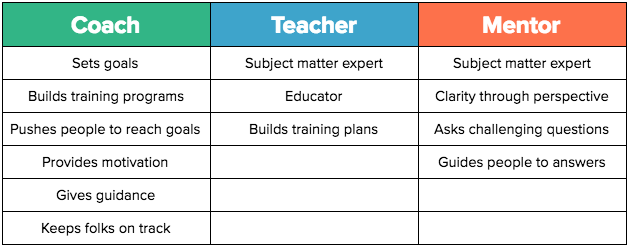
When you’re a coach you listen, advise in ways to help reach goals (that our subject has articulated), and conduct exercises to continue growth.
In this stance, you know your subject has the answer inside of them. They know what they must do -- but they can’t connect the dots. This is where true growth for your people happens. When you are the coach, you are showing them that they have what it takes to handle their own situations.
When you’re a teacher, you are instructing your subject on something that you have greater knowledge about, usually related to skills.
While in this role, you need to remember you still may have things to learn from your subject, even though you have more overall knowledge in the subject area. This is the stance where you are actually teaching a skill, not simply helping them connect the dots.
Finally, when you’re a mentor, you bring perspective to situations. You can add clarity and experience to situations your subject presents.
The key, of course, is that you must be all three at once -- coach, teacher, and mentor -- because each of these roles play off of each other.
You need to understand each situation you are in and decide which hat you need to wear. Throughout your interactions with your team, you will find yourself jumping between all three roles as they apply to helping people at different stages of their development, based on what they need.
As I think about this, I reflect back to where I first heard about this blended approach and saw it in practice.
Like many of my experiences, this, too, dates back to my time in the Army.
When we talked about developing the idea of coaching, teaching, and mentoring back then, soldiers were discussed a ton. It was how both noncommissioned officers and officers alike spoke about training.
Part of almost all training in the Army had some form of instruction (teaching). Then there were the practical exercises and drills, where the leaders made on-the-spot corrections or gave follow-on instructions (coaching). Finally, the training conducted “after action” reviews or follow-on discussion about what was taught (mentoring).
Over and over again. Instruct, practice, review…lather, rinse, repeat.
This idea was great for field training and learning the basics of soldiering, but didn’t always follow in our day-to-day interactions or when we were working on staff work, which is more similar to office work in the civilian world.
I can still remember the first leader who took the coach, teacher, and mentor idea away from simply training me to be an infantryman, and utilized it to develop me as a leader and human.
This story dates back to when I was the Deputy Plans Officer in 1st Brigade, 82nd Airborne Division. Then Major Adam Barlow -- now Lieutenant Colonel (LTC) Barlow -- was my boss, the Brigade Plans Officer.
I remember my first counseling session with LTC Barlow. He told me his life story and who he was. It was the first time in my career that an initial counseling started this way. We talked, he set expectations, and he gave me my first homework assignment:
Read A Message to Garcia -- considered required reading by many in the military.
Document Source: MIT
This was his first lesson to me.
“Learn to take initiative, make things happen, and get after it.”
This initial lesson led to a relationship where I still think of LTC Barlow as a mentor. Even though we are in different fields, have different beliefs on many topics, and haven’t seen each other for years.
During that time, he seamlessly flexed between coach, teacher, and mentor, depending on what I needed.
When I was in command and struggling with a tough decision, he took the role mentor. He had faced similar situations and knew how to help me negotiate the correct path. When I needed a kick in the behind, for one reason or another, he put on his coaching hat and let me know where I was falling short. As I hit areas that were new for me, he would become the teacher -- well, really more of the professor based on his level of experience and expertise -- and help me to understand not only what I needed to do, but also why and how.
I am the leader I am today because of leaders like LTC Barlow. He wasn’t the only leader that I had that embodied this, but he was the most influential, in terms of who I am today as a leader.
As we embark on the journey to becoming an inbound leader it is clear to me that we must start as coaches, teachers, and mentors. If we can do this and model these behaviors we will put our people on the path to continued success and growth.
If you are serious about becoming an inbound leader and building the coach, teacher, mentor mindset, here are a few things to read, watch, and do…
What is Inbound Leadership? 3 Fundamentals For a Team That Opts In by yours truly
The Coaching Habit: Say Less, Ask More, & Change the Way You Lead Forever by Michael Bungay Stanier
Multipliers: How the Best Leaders Make Everyone Smarter by Liz Wiseman
Growth Mindset by Carol Dweck (an animated book summary)
Developing a Growth Mindset with Carol Dweck
Listen, Learn… Then Lead with General Stanley McChrystal
Take 10 minutes to think about your interactions with your team from this week by asking yourself the following three questions:
How many times were you the coach?
How many times were you the teacher?
How many times were you the mentor?
As you reflect, I challenge you to ask yourself the following:
Were those the right stances to adopt in those situations?
Did your teammate come to you to help them see something differently and connect the dots (looking for a coach), but you responded as the teacher instead, giving them the answer, rather than helping them get to that conclusion on their own?
Also, evaluate if you have a preferred stance. Based on what we’ve talked about, is your usual stance helpful? If not, simply be aware of your bias and take a moment to think about what your people are actually coming to you for, before fully choosing which stance to take.
For you to be able to operate from a “How can I help?” perspective, obsessed with the success of your people and teams -- leading to a positive and lasting impact on the organization, you must build this foundation.
As General McChrystal says in the TED Talk I linked above, there is an “inversion of expertise” today. Technology is constantly changing, and leaders are not always the expert anymore:
“A leader isn’t good because they’re right; they’re good because they’re willing to learn and to trust.”
As you develop this skill set, which won’t always be a cakewalk, remember that everything you’re doing is to help your people and your organization succeed.
You’re working to be better today than yesterday.
That’s our goal. That’s what we’re working toward.
Now that we have our foundation in place, let’s talk about the three key principles of inbound leadership.
Chapter 3
So far we have agreed -- remember you’re on this journey with me -- that we are looking for long-term success for our organizations. We have also agreed we need to take a long-term leadership approach.
We know the key to increased employee engagement is through better leadership -- leadership focused on the development of our people -- who make up our companies.
So, it shouldn’t be a surprise that the first inbound leadership principle is people first.
There is a business idea that the customer comes first, especially since they’re always right -- right?
Actually, I don’t believe this.
I don’t think putting the customer first actually helps our businesses or our customers, for that matter. And yet I have heard plenty of business owners and organizational leaders -- all of whom I have the utmost respect for -- continually preach this faulty gospel.
Every time I hear it I say to myself, “You are so wrong.”
Then I ask, “So, where do your employees come in?”
You know, the employees that make all the widgets for your customers, the employees that service your clients, the employees that take care of your clients?
If we live by the maxim of putting the customer first, we are placing our employees second, at best. Although, in reality, employees usually will end up behind shareholder, which puts them in third place, in order of importance.
Please tell me I’m not the only who thinks this is ridiculous.
If we place our people first -- you know, our employees who do all of the work, so our customers buy things from us -- we are setting the conditions for our customers and clients to have a great experience with our company.
They are much more likely to encounter engaged, happy employees who are ready to make their interaction with our company great. If our employees are doing this, our customers are happy, which leads to increased revenue and profits, thus delivering for our shareholders.
By starting first with our people, everybody wins.
Winning as an organization doesn’t have to be a zero-sum game.
So, if we can agree that it’s a smart business decision to place our people first, now let's talk about how we can implement it in our companies.
When we put our people first it isn’t as simple as giving them snacks, beer, and ping-pong tables. (Oh, to live in a world where you can solve all of your business problems by throwing IPAs and Wheat Thins at them.)
It’s about ensuring that we, as inbound leaders, are delivering on the needs of our people.
Gallup conducted a study from 2005 to 2008 that explored the reasons why people follow leaders. Their results identified four basic needs of followers -- trust, compassion, stability, and hope.
So, how do we provide for these basic needs and how does it apply to inbound leadership?
Meaning not only are we sharing information or data with our team, but we are also ensuring they understand what it means.
In my view, this is the easiest way to build organizational trust with your team. When leaders are transparent they are actively showing their people that they are valued and trusted members of the team. (It may take a few tries to strike the balance, but we’ve seen first-hand at IMPACT that practice makes perfect -- and our people respond.)
If all you’re doing is placing information on a wiki or sending out a powerpoint with data, you are being transparent, but you aren’t fully getting there. To truly put your people first, you need to go out of your way to confirm they know what they’re looking at and what it means.
While this is a key to putting our people first, it's true that we can’t be transparent with everything.
There are some things that aren’t for everyone’s eyes and that's OK. That said, in the spirit of active transparency, we can let people know what types of things we aren’t going to share. For example, we don’t share individual salaries at IMPACT, and our people know that.
**Note from Chris’ Editor: Let’s not be too hasty. Free beer is fantastic.
“Setting the conditions for success” isn’t leadership speak for setting up every project for our teams or telling them exactly what to do. It’s more fundamental than that.
Setting the conditions for success revolves around ensuring that our people understand what's expected of them, that they have access to the resources they need, and that they are given the autonomy to get after it.
Spotify does a great job of talking about this in their culture code.
One of the main points they make is the idea of aligned autonomy. The principle states that when we have aligned autonomy, leaders are identifying problems but allowing teams to find the solutions.
The next step is simply ensuring that the team has the resources, tools, or access to what they need to get the job done.
To do all of this, everyone must understand their role, as well as what’s expected of them and how they can get promoted. When people know these things, they can move into this type of environment.
I went a whole section without saying the word “obsessed,” so let’s make up for lost time, shall we?
Being obsessed with the success of your people goes way beyond simply praising people when they succeed. As we think about active transparency and setting conditions, we must attack these from the perspective of how will this empower our people to succeed.
It’s super easy.
(Just kidding.)
When we are identifying issues and trying to diagnose what is going wrong in our teams or our companies, we need to first look at ourselves and our leadership teams. We have to look and see if we are setting the conditions for our people to be successful, which in turn sets the organization up for success.
These are tough questions, but you have to be willing to ask them and answer them honestly. If you do, you’ll be rewarded with engaged, autonomous employees who are excited to get stuff done.
There are other ways to put your people first, but being actively transparent, setting the conditions for success, and obsessing about the success of your people are absolutely essential.
As you go down this journey as an inbound leader, you will naturally put your people first. It will become part of who you are. As you become more self-aware and work to practice these three ideas, you will naturally become more others-aware.
Here’s the bottom line -- you’ll have teams filled engaged folks who are motivated to make the organization better.
Really, that’s it. It’s that simple. (Thank you for coming to my TED talk.)
Back when I was in command in the Army, my first sergeant and I took this approach.
We were actively transparent with everything we could be. We explained the why behind decisions and ensured each trooper understood what we were sharing. We did our best to allow for aligned autonomy -- though we didn’t know that’s what it was called -- identifying problems that needed to be fixed, but we never told our leaders how to fix them.
And when things didn’t go to plan, we looked at ourselves -- not our troopers -- and asked, “What could we have done better? What didn’t we give the team?”
This led to our company being one of the top companies in our brigade in every metric we had. Our climate was amazing, and I have (or I should say had) the command climate surveys to prove it.
I left command over five years ago.
To this day, I remain in contact with many of the troopers that I had the honor to lead.
This wasn’t because I was the smartest commander or the best leader; it was because my leadership team embraced a trooper-first mentality, ensuring our troopers knew how much we cared about them.
This can be you.
Like many things in life, your journey toward becoming a people-first inbound leader will be a personal one. You, as the inbound leader, can make the decision to put your people first very easily. However, depending on your role, you may not get full adoption within your organization.
If you make the choice to lead this way and model the behavior, the results of your shift in leadership will present themselves in your team's results.
Be prepared for objections focused on customers and shareholders, and why they should come first. This will likely come from folks focused on short-term results. The counter here is pretty simple.
Ask them if they want to follow a long-term approach to the business that will allow for sustained growth, or if they want a short-term solution that has doesn’t account for long-term success.
Leaders Eat Last: Why Some Teams Pull Together and Others Don't, by Simon Sinek
Drive: The Surprising Truth About What Motivates Us by Daniel Pink
The Culture Code: The Secrets of Highly Successful Groups by Daniel Coyle
Why the World Needs Mindful Leaders with Matt Thieleman
Why Good Leaders Make You Feel Safe with Simon Sinek
On a scale of 1 to 10 -- with 10 being the best -- grade yourself on how well you and your leadership team are practicing putting your people first in each of the following categories:
Active transparency
Setting conditions for success
Obsession with the success of your people
From there, identify one thing you can start doing differently immediately that would improve the outcomes of this assessment.
When you first start out, practice this exercise weekly to get in the habit of self-reflection and awareness as a new inbound leader. The key to this is that by continually thinking about how you are doing, you will be more inclined to think about your people first as a natural reflex.
Never use money as your only way of putting people first. Money is a good thing and a powerful motivator, but it doesn’t work.
Even if you get short-term gains out of dangling dollar bills in front of your people to improve performance, it reinforces a transactional environment where extrinsic motivations take over, rather than intrinsic motivations of greater purpose and personal fulfillment.
Chapter 4
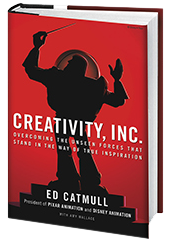 Soon after I started at IMPACT, I read Creativity Inc., by Ed Catmull, the current president of Pixar and Disney Animation Studios.
Soon after I started at IMPACT, I read Creativity Inc., by Ed Catmull, the current president of Pixar and Disney Animation Studios.
In the spirit of active transparency, I’ll admit I read this book because I didn’t know if I was creative enough and wanted to read about creativity. (Long story short, I’m no Picasso, but I underestimated my creativity. I digress...)
So, I read the book and was amazed. The stories that Catmull tells are truly inspiring.
Pixar created a culture and environment of collaboration and candor. One that has brought us classics like Toy Story, Brave, and Monsters Inc., to name a few.
How did they do it, and how do they continue to do it?
They collaborate with a level of candor that many teams don’t even come close to.
This is manifested in what they call the “Braintrust.” The Braintrust is a cross-functional group of people from across all levels of the organization -- and the key is that everyone must bring a level of candor to these meetings.
When they meet, they review films and provide feedback to the director. Again, they must be candid in their feedback, because their goal is to take their films from not so good to great.
Or as Catmull would say, “From suck to not-suck.”
Pixar brings in people from throughout the organization to help them in the decision-making process of what should be in a movie and what shouldn’t. They also have leaders that accept and ask for feedback as a way to make things better.
What Pixar shows us is that when we, as leaders, bring our people into the decision-making process and let them get their hands dirty, we can create moments of magic.
We know this, because Pixar isn’t an outlier. There are lots of organizations and teams that operate this way. And when we look at teams that thrive, they do so because the team multiplies what each team member brings to the task at hand or project.
Rather than the leader simply making decisions based on their own knowledge and skills, they reach out to their team to ensure the right solution is decided on.
Of course, bringing people into decision making doesn’t mean that your organization becomes a democracy. It simply means that you, as the leader, are open to hearing and working through all the ideas, so that you and your team can make the best decision you can, at the time.
When implemented properly, teams will take ownership of their work, since they were a part of bringing it to life. Even when we don’t use every idea we hear, the simple fact that our people were part of the decision-making process, gets us the ownership and engagement needed for us to get the outcomes we are striving for.
This approach also shows our people that we value them.
We see that they have ideas or solutions to offer that may differ from ours, but that we, as the inbound leader, are open to hearing them and even having them change our mind.
This is rather straightforward -- the key to collaborating effectively is communicating effectively.
Effective communication is at the heart of what is needed as an inbound leader. If we cannot communicate our message effectively, then we cannot lead effectively. But rather than living by the motto, “The only thing I can do is talk louder,” let’s look at how inbound leaders get communication right.
So, it took me a little too long to learn this.
I always thought that, as the leader, I was supposed to fill the gaps in conversations and replace awkward silence with something to move us forward. Yikes. Needless to say, this approach totally backfired.
All I did was create a total dependency on me and a lack of initiative from my teams.
Unfortunately, I didn’t figure this out until I was deployed in Afghanistan and was told explicitly that if I cut my boss off one more time he was going to punch me in the face.
That incident forced me to look deeper and realize that by cutting people off I wasn’t actually listening to understand. I was listening to respond and tell people why my way was right.
After this encounter, I adopted a system involving pens to ensure that I listen.
That system may sound strange, but by forcing myself to focus on listening with such vigilance, I’ve become a much, much better collaborator. Now, I focus on what others are saying, rather than trying to force my opinion down on the team, and no one wants to punch me in the face. I think.
When we approach our teams from this position -- where we focus on listening to their ideas so we understand them, instead of listening to respond with why they’re wrong -- we can unleash new potential that we didn’t even know existed.
Get the Full Story:
Feedback -- giving and receiving -- is not easy. But to be an effective inbound leader, we need to be able to do both.
The funny thing is most new leaders and many seasoned ones tend to only focus on giving feedback. While this is a huge component to leading, there are two Jedi inbound leader skills we need to create.
Giving feedback from a compassionate “How can I help?” position, where we help our folks self-discover their improvement opportunities.
Receiving feedback from our teams, without reacting to it, and then addressing the feedback.
To help us see how we can conquer the feedback monster, let’s take a look a few totally made up examples that could happen in any organization. These are made up but could happen in any organization.
.png?width=1000&name=FEEDBACK%20IS%20REALLY%20HARD%20UNIT%20(1).png)
In the inbound leadership system, leaders must be good at feedback in two separate, but equally important ways -- giving feedback that’s actually helpful, and receiving feedback without being a defensive, reactionary blowhard. These are some examples. Doink, doink.
Boss: Look, I’ve got to be honest with you. Yesterday’s presentation wasn’t your best work. I don’t think the approach you used set us up for success -- I expected better from you.
Team Member: Oh. I worked really hard on it and thought it was great.
Boss: Well, I appreciate that, but it wasn’t great. You need to up your game next time, because we can’t have that happen again.
Team Member: (Internally) Nothing I do is ever good enough. My boss hates me. I don’t know why I even try…
Have you ever been part of a conversation like that? It isn’t fun. I don’t think the “boss” in the example intends to be negative, but the approach they take leads to a negative outcome.
Now, let’s take replay that example with a different feedback strategy.
Boss: Hey, do you have a second to talk about yesterday’s presentation? I’d like to hear what you thought about it.
Team Member: Sure. I thought it went well. I put a ton of work into it.
Boss: I definitely saw how much work you put into it. If you could do it again is there anything you would change?
Team Member: Well, I probably would have changed our approach to laying out the information to better tell the story we were trying to.
Boss: That’s a great insight. How do you think you’ll approach it next time?
Team Member: Maybe we could do a more thorough rehearsal prior to the briefing. Sound good?
Boss: I love that idea. Count me in.
Team Member: (Internally) This boss values me, and I do not want to punch him in the face at all.
(Even though I’m writing this at a coffee shop, this isn’t my screenplay -- it’s just an example of how a conversation could go.)
In this example, the “boss” asks to have the conversation and then asks for their teammate's thoughts, rather than sharing what they think. Then the “boss” acknowledges the hard work the teammate put in and asks for their opinion on what could have been better.
This approach leads the teammate to self-identify the shortcomings and truly learn from the feedback. Things end with the teammate creating a solution to the problem, to which the boss responds with praise, rather than the teammate being left feeling horrible.
So, if we help our team self-discover their areas to improve by asking good questions, we can tackle the feedback monster. Of course, there are times when you may need to be more direct, but I have found throughout my years of doing this, it is much more effective when your teammates identify their own issues. With a little help, of course.
I am going to approach this from the perspective of a leader receiving feedback from a teammate. The overarching theme though applies to everyone.
Team Member: Hey boss, can we talk?
Boss: Sure, what’s up?
Team Member: I don’t see how this new initiative is going to help us achieve our goals. I think there are other ways we could align our activities to reach our objects, and I have a few ideas I’d love to share with you.
Boss: Don’t worry, this is the way forward. You’ll see.
Team Member: If you’ll just hear me out, I really think we need to be going in a different direction.
Boss: I understand you see it differently, but you’re wrong. The plan stands, as-is.
Team Member: (Internally) Well, it looks like my opinion doesn’t matter here. Maybe I should look at that other job my friend sent me yesterday.
See what I mean? The “boss” never listened. Instead, they doubled-down and told the employee their thoughts didn’t matter.
Here is the inbound leader way of handling feedback.
Team Member: Hey boss, can we talk?
Boss: Sure, what’s up?
Team Member: I don’t see how this new initiative is going to help us achieve our goals. I think there are other ways we could align our activities to reach our objects, and I have a few ideas I’d love to share with you.
Boss: OK. (Takes a deep breath.) Can you help me understand what you mean?
Team Member: I don’t see the connection between the strategy you shared with the team and our objectives -- it seems like we are shifting our focus away from what matters most.
Boss: So, If I hear you correctly, you’re having a hard time connecting the new initiative with our end of year goals, and you don’t agree with the change in focus.
Team Member: Right.
Boss: OK, well, let’s unpack this new initiative and talk through all of your questions and ideas -- we’ll see if we can find that connection together.
In this scenario, rather than reacting, the “boss” chooses to create a bit of space to find the underlying issue, allowing for shared understanding and for their team member to feel valued.
Are these examples lightweight? Yes, but these are the two most common feedback traps inbound leaders can fall into. The key here is not that we eliminate the feedback monster, but rather we make the necessary room to have a positive impact on both us, as a leader, and on our team members.
As a result, you’ll transform your feedback monster wreaking havoc into an energy source that creates more opportunity for collaboration and growth within your team. Otherwise, we run the risk of alienating people and having them become disengaged. The same happens if we react to feedback, rather than do our best to understand it.
We’ve identified the two components needed for collaboration to grow on your team -- listening, and effectively giving and receiving feedback. But we haven’t yet talked about how we can set the conditions for ourselves to be able to handle these two things.
…or have we?
When we go back to our foundation as inbound leaders, we remember that we are coaches, teachers, and mentors, not dictators. This means we have already put ourselves in the mindset that we may learn from our folks as much as they will learn from us.
We aren’t frightened for feedback; we welcome it with open arms.
As Brian Halligan, CEO and cofounder of HubSpot says, "Feedback is the breakfast of champions."
I don’t know if there is a better way to put it. Inbound leaders seek feedback and give it to their people in a way that inspires action, instead of limiting performance.
Radical Candor: Be a Kickass Boss Without Losing Your Humanity by Kim Scott
Creativity Inc., Overcoming the Unseen Forces That Stand in the Way of True Inspiration by Amy Wallace and Ed Catmull
How You Can Become a Multiplier with Liz Wiseman
Stop filling the awkward silences in meetings. Instead, every time you feel the urge to share an opinion, ask someone from your team about their thoughts instead.
Don’t fake being a collaborator, which means don’t do what we talked about above if you’re not open to actually thinking that there is another way other than the one you’ve identified. If your mind is made up don’t fake collaboration.
Chapter 5
Some wise person who probably lived in the mountains once said, “The only constant in life is change.”
If we agree with this, then we must learn to be adaptable as inbound leaders, in the face of the inevitable parade of change.
You, as the inbound leader, must set the tone here. You, as the inbound leader, must be aware of your environment and lead your team through changes.
It was the summer of 2011, and I was a deputy planner for 1st Brigade of the 82nd Airborne Division. We were slated to be the nation’s quick response force -- the unit that, in an emergency, the President can send anywhere in the world in 96 hours.
This meant we trained and trained and trained for an operation called Airfield Seizure, wherein our unit would jump onto an airfield and seize it in preparation for follow-on forces to be able to land on the airfield.

Suddenly, we were notified that our mission had changed.
We weren’t going to be the quick response force in a few months; we were deploying to Afghanistan in six months. (In my experience, units outside of the special operations community usually knew about deployments with significantly more notice than we had.)
In a split second, all of the planning we had done as a brigade to assume the quick response force mission to conduct airfield seizure, was thrown out the door.
Now we had to prepare ourselves to go to Afghanistan to conduct counter-insurgency operations against the Taliban during the fighting season. This meant conducting ground movement operations and learning how to use vehicles to support operations.
No jumping, no airfield seizure. We would have to learn how to work with the Afghans and focus on operations that we hadn’t been training on.
The brigade leadership and staff had to come together to build a new training program to get the brigade ready. We had to collaborate, and we had to embrace this new reality.
By early 2012, we were in Afghanistan, conducting this new mission countering the Taliban’s increased presence in our area of operations. It wasn’t easy, but because the leaders at all levels of the brigade embraced the change, put their troopers first, and ensured we collaborated, the brigade was able to take the fight to the enemy.
My part in the above story was that of a staff planner.
When I got to the 82nd and was assigned to this role, I thought I would spend some time on staff, working through training plans and rehearsals for our global response force mission, get a bunch of jumps under my belt, and then (at some point) take command.
Instead, when all of this changed, this staff position went from one where I’d do all of the above, to one that had to synchronize the planning efforts.
I would eventually be one of the first members of our brigade in Afghanistan to ensure our Troopers made it from where we entered Afghanistan into our area of operations and, much later, I would take command, as we were redeploying.
As inbound leaders, we must be able to change with the unpredictable conditions of our environments.
“Plans are worthless, but planning is everything.”
This is one of my favorite quotes from President Dwight Eisenhower, because it cuts right to the punchline. This is what we need to do as inbound leaders.
But when we think about the idea of “planning is everything,” we need to understand what goes into planning -- analysis of the situation (market, product, change, etc.), development of courses of action and their implications, and what the end states may be.
If we conduct our planning properly, evaluating all factors when conditions change, we will have done the necessary work to be able to adapt and respond to the changes in a way that will drive us towards success.
Adaptability is the third principle of inbound leadership for a reason.
To be able to truly adapt, you need to understand what putting your people first means. You must understand that it is only possible to be adaptable as a leader (in a way that is sustainable) if you collaborate, and bring your team into the decision-making and planning.
However, if all you do is react to situations, you will lose your team.
You will naturally revert back into the transactional leader who can only see what is right in front of you. You will have turned off your ability to see what you and your team are actually working towards. Everything will become a crisis.
You can’t develop your people or build toward long-term success this way.
Band of Brothers: E Company, 506th Regiment, 101st Airborne from Normandy to Hitler's Eagle's Nest by Stephen E. Ambrose
Shoe Dog: A Memoir by the Creator of Nike by Phil Knight
Listen, Learn… Then Lead with General Stanley McChrystal
Take a look at what you and your team want to achieve in the next week, month, or quarter. Identify and write down the measurable results you are looking to achieve, as well as what impacts those results will have on your team or organization.
Next, write down the things that may go wrong -- things that could affect you and your team’s ability to achieve objectives. What actions can you take to allow you to have the ability to adapt if any of those come up? Write down your answers and then pat yourself on the back -- you're on your way to being an amazing planner and an adaptable inbound leader.
Chapter 6
We’re almost there!
We've looked at what inbound leadership is, where it came from, and its foundation and principles.
Now, we need to talk about how we can actually start walking the path to become a different kind of leader -- an inbound leader.
Being an inbound leader is a shift from what most people think of when they think of a leader. Rather than being outwardly tough, inbound leaders are masters of themselves -- or at least strive to be.
We focus on self-mastery in order to allow ourselves to be the coach, teacher, and mentor for our people. We are constantly learning and developing our skill sets, so we can help our teams achieve success.
Our mindset shifts from, “How do I achieve success,” to “How do we achieve success?”
When we receive criticism or negative feedback when something doesn’t go as planned we don’t first look to our team and shift blame, we focus it on ourselves.
‘What could I have done better to set the team up for success?”
Shifting my mental posture to be an inbound leader took a lot of work -- in fact, it took me the better part of a decade to realize and fully embrace it. And it didn’t happen all at once. I took on bits and pieces of being an inbound leader when I was in command, but I still had the old leader in me as well -- concerned with my own success and not fully taking others into account.
I struggled with my own ego. I wanted to be the best. I wanted to be the #1 company commander in the brigade. I wanted to be the hero of the story.
It was when I was able to remove the ego, bit by bit each day, that I began to see what was possible. When I no longer saw myself as the hero, I was able to make my team the hero, which made me a much better leader.
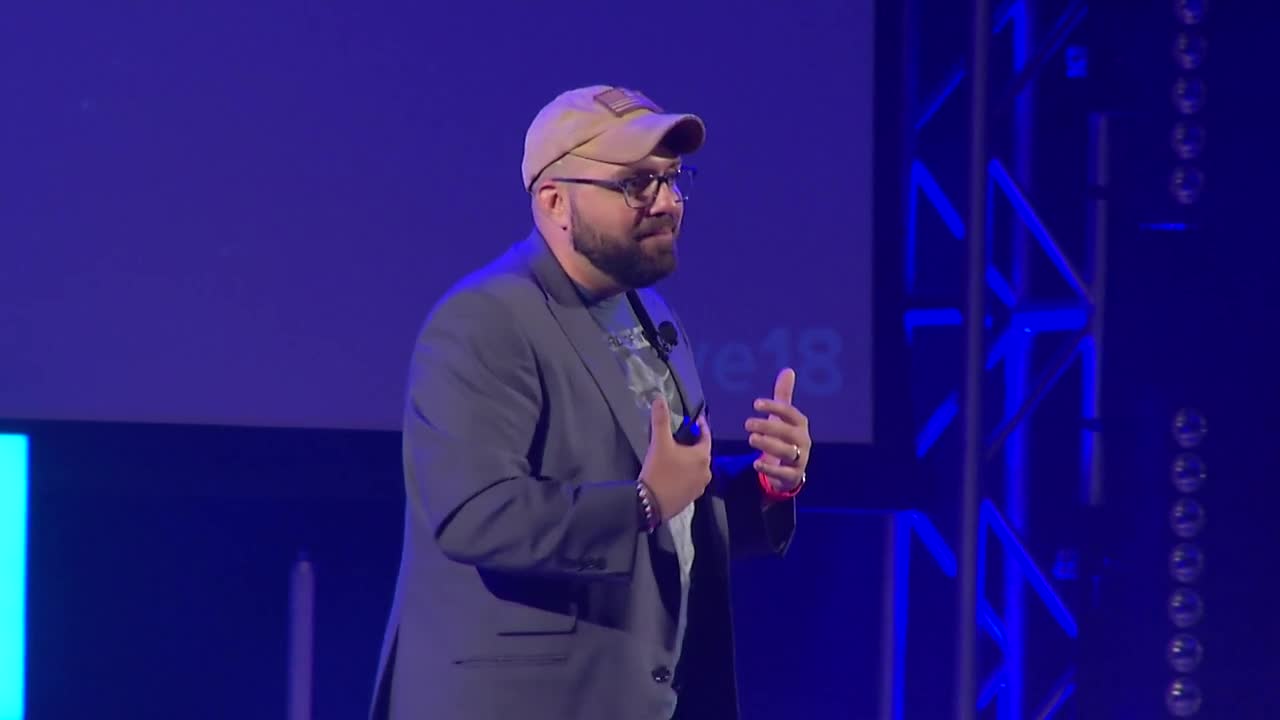
Watch my IMPACT Live talk in inbound leadership
Throughout my leadership journey, I have had flashes of insight that have all led to this moment, where I find myself sitting down and pouring out all of my ideas around inbound leadership, with the hope that it will help all of you.
As we look to how we can get more leaders to lead from an inbound perspective and become inbound leaders, we need to realize that simply making the shift in thinking is a huge win.
Putting ourselves on the journey to be an inbound leader is really the goal.
We are going to revert back to our old styles or fall into our old habits at times; it’s human nature. We are going to have periods of time when we don’t want to listen or collaborate -- where we want to put ourselves first.
These situations will happen. When they do, try not to judge yourself. Simply by identifying these thoughts and feelings (and not judging), you will naturally revert back to being an inbound leader or more accurately be thinking like one.
The key here is that we make a decision to lead in a different way.
That we accept that we can have a positive, lasting impact on our businesses, and on the people we work with and lead. The journey isn’t easy, but when made, it proves to be worth it.
Chapter 7
I know what you’re thinking. Why are we this far into this page and we’re now just starting to talk about purpose?
The foundation and principles of inbound leadership must be understood before we dive into purpose. The mindset shift that is necessary to lead in this way is critical, and if we simply start with purpose, we may get stuck there…
To be clear, when I talk about purpose within the context of inbound leadership, I am referring to an organization’s purpose:
If you are in an organization and you can’t answer these questions, you are going to struggle with implementing inbound leadership.
If your organization is solely focused on results, your senior leadership will not be open to embracing this long-term leadership approach. They are more likely to be focused on short-term results and ways to simply drive earnings.
I didn’t say it’s impossible -- it will just be a struggle.
When organizations have a purpose, they are generally more focused on long-term success. When this is the case, everyone in the organization can rally around their purpose. They can see how their job fits into the bigger picture. It sets the stage for people to naturally be engaged with what they do.

These are the initial conditions that will allow for an inbound leadership approach. People aren’t usually seen as numbers in companies with an understanding of their purpose; they’re seen as people
Clarity of organizational purpose will guide hiring practices, meaning that the folks that enter the organization are more likely to be aligned with the purpose. As a result, they are going to be more open to doing whatever they can to make the purpose real.
And if you’re an inbound leader with a team full of engaged employees who are aligned around one shared purpose, establishing the three principles of inbound leadership within your organization will be much easier.
You can be the coach, teacher, and mentor, helping to focus and align the team rather than constantly having to drive behaviors that support your purpose.
Chapter 8
(See what I did there?)
Thank you for making it this far. If you’re still reading, you're already an inbound leader, because you believe in what’s possible. You can see that our former thoughts or stereotypes of what a leader is or should be don’t have to be true.
The road to inbound leadership is a challenging one. As I’ve shared with you, it has taken me almost 15 years to figure this out.
But right now, I want you to hit the pause button.
Take a deep breath.
Then, remember what I said at the beginning -- this isn’t a formula for creating immediate results.
You aren’t going to do everything here overnight and then have the greatest team or organization in the world the next day.
While these ideas, the foundational mindset, and the principles behind inbound leadership are integral to your success as an inbound leader, more is still required of you. What we’ve covered here is the essence of inbound leadership, it is still up to you, the inbound leader, to live them.
It must be who you are.
When we can do this, we see some amazing things.
As you start or continue on this journey of inbound leadership, it’s important to check-in on yourself.
This can be done in a ton of ways, but here are a few suggestions:
Create or join a group of like-minded leaders.
Start working with a coach.
Talk to your spouse or significant other.
Work with your boss.
Do a 360-degree assessment.
Develop a practice of mindful meditation.
No matter how you choose to reflect or check-in, you are going to learn things about yourself that will help you be the leader you desire to be.
And in times of doubt, return to the wise words of Stephen Covey of starting “with the end in mind.” From my own experience, I can say that I’ve had to remind myself this a ton.
But you know where you want to go -- now it’s time to get after it.
The short answer is yes. The longer answer involves several lines of questioning that ultimately lead back to deciding if you want short-term results or long-term success that’s sustainable.
There’s a reason why we’ve seen such massive shifts in the way people think about leadership.
The Army (where I began my official leadership journey) made a drastic pivot from command-and-control to mission command, where intent is the key and subordinate leaders have the leeway to make decisions to achieve desired end states.
Now, leaders like General McChrystal are preaching about leadership and team-building. Why?
Because the old carrot and stick approach doesn’t work today. The world is a different place, and so is the modern workplace.
As I look at my career -- both in the military and in the civilian world -- I can say this with confidence. The organizations that have adopted an inbound leadership philosophy and culture focused on the success of their people have been the places where leaders are born and success is had by all.
And when the opposite is true, I have seen the leader succeed (temporarily) at the cost of their people.
When we put our people first and truly care more about their success than anything else -- leading as inbound leaders -- we put ourselves in a position where loyalty is not only something talked about, it becomes part of the DNA of the organization.
Inbound leaders allow organizations to bend, but not break.
Fostering inbound leadership within yourself and others will get you through the tough times that are inevitable, no matter how good your service or product is. You are future-proofing your organization.
As an inbound leader, you’ll start to hear your team talking about solutions to problems without you asking for their help. You’ll see people living in solutions rather than simply complaining about what’s not working.
You’ll be able to identify problems and watch your team come together to work on how they are going to solve it. Your people will care about the organization, because they know the organization cares about them.
Imagine a world where every organization leads in this way.
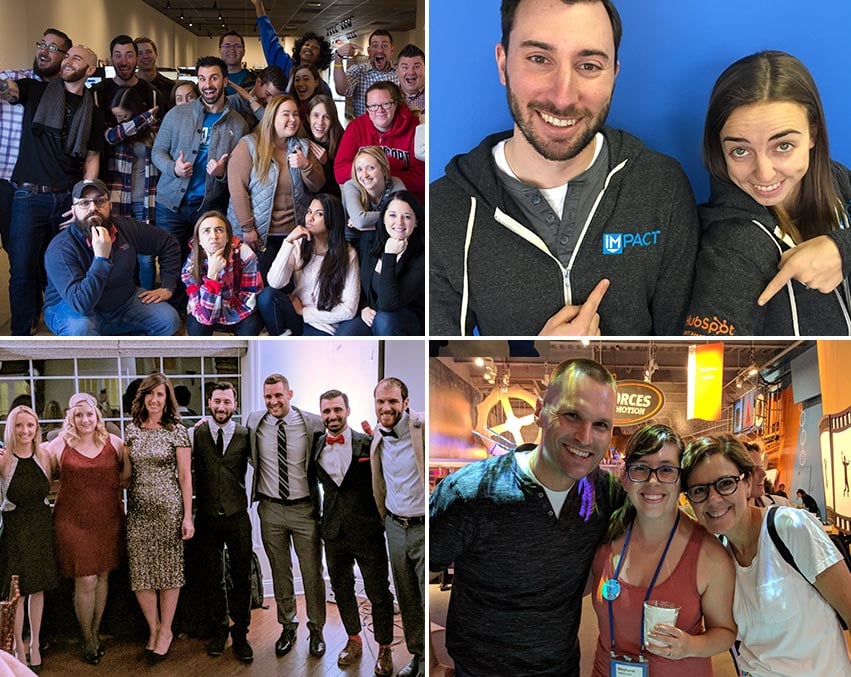
Those scary employee engagement numbers would completely change. Because when we lead as inbound leaders, we are actively fixing the disengagement problem in the workplace.
To give you an example of what’s possible I’ll share a brief story from IMPACT.
Recently, we’ve seen that we have some issues that we (leadership) created with respect to structure and process. Our CEO, Bob Ruffolo, created a video for the team letting them know he understood the problems, and he laid out some thoughts on how we could overcome them.
But then Bob did something that most CEOs wouldn’t do. He asked the entire company for their thoughts about his video. Then he created a shared Google Document to capture all of the feedback.
What do you think happened next?
More than half of our employees dove into the document to share their feedback -- it ended up being 25 pages long, by the time everyone chimed in. One IMPACTer even sent a video back in response. Everyone in the organization started to become part of the solution rather than simply blaming leadership or throwing in the towel.
Inbound leadership isn’t a trend, nor is it something we came up with to sound cool.
The core of inbound leadership comes from many places, from the experiences of many. It will evolve and adapt, but the idea will remain the same.
If we all strive to be inbound leaders who operate from the perspective of “How can I help?” and are obsessed with helping our people succeed, we will see the long-term success we all strive for.
Let's talk. We respond to requests immediately, so we'll be in touch very soon!
Talk to us